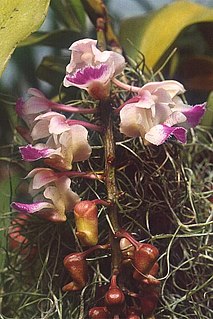
In the botanical classification of plants, Aeridinae is a subtribe of the Tribe Vandeae whose representatives all have a monopodial growth habit and do not possess pseudobulbs.

Pogostemon is a large genus from the family Lamiaceae, first described as a genus in 1815. It is native to warmer parts of Asia, Africa, and Australia.
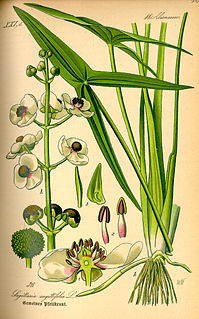
Sagittaria is a genus of about 30 species of aquatic plants whose members go by a variety of common names, including arrowhead, duck potato, katniss, Omodaka, swamp potato, tule potato, and wapato. Most are native to South, Central, and North America, but there are also some from Europe, Africa, and Asia.
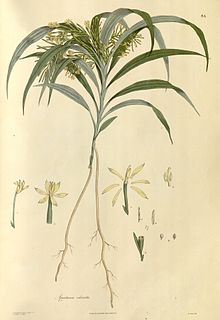
Apostasia, commonly known as grass orchids, is a genus of eight species of primitive orchids in the family Orchidaceae. They are terrestrial, evergreen, grass-like plants, barely recognisable as orchids and are distributed in humid areas of the Himalayan region, China, India, Sri Lanka, Southeast Asia, New Guinea, and Queensland. They have many narrow leaves and small yellow or white, non-resupinate, star-like flowers usually arranged on a branched flowering stem.

Ipsea is a genus of the Orchid family (Orchidaceae), with three species that are found in India, Sri Lanka and Thailand.

Nephelaphyllum is a genus with 12 species of orchids. Its genus is distributed in southern China, the Himalayas, Indochina, Indonesia, Malaysia and the Philippines.

Cyanotis is a genus of mainly perennial plants in the family Commelinaceae, first described in 1825. It is native to Africa, southern Asia, and northern Australia.

Gastrochilus, abbreviated Gchls in horticultural trade, is a genus of plant in family Orchidaceae. It is native to eastern and southeastern Asia, including China, Japan, Bangladesh, Thailand, Malaysia, Indonesia, the Philippines, etc.
Wiesneria is a genus in the family Alismataceae. The plant usually lives in natural temporary water pools on lateritic plateaus. Wiesneria triandra was first described in the south of the Indian state of Maharashtra. They are well spread out over the regions they occupy and have no common uses, making them of least concern.

Dendrobium nobile, commonly known as the noble dendrobium, is a member of the family Orchidaceae. It has become a popular cultivated decorative house plant, because it produces colourful blooms in winter and spring, at a time when little else is in flower. It is also one of the 50 fundamental herbs used in traditional Chinese medicine, known as shí hú or shí hú lán. Dendrobium nobile is one of the most widespread ornamental members of the orchid family. Its blooms are variegated in colour, shading from white through pink and purple, and the many different cultivated varieties produce different sized and coloured blooms.

Brachycorythis is a genus of flowering plants from the orchid family, Orchidaceae. It contains approximately 40-50 species native mostly to Africa and Madagascar but also some from South and East Asia.
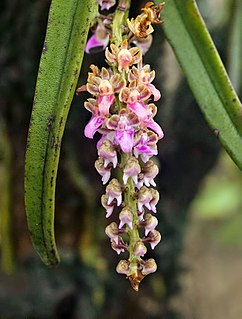
Diplocentrum is a genus of flowering plants from the orchid family, Orchidaceae. It has two known species:
Xenikophyton is a genus of flowering plants from the orchid family, Orchidaceae. It contains two known species, both endemic to India.

Papilionanthe is a genus of flowering plants from the orchid family, Orchidaceae. It is native to Southeast Asia, southern China, and the Indian Subcontinent.
- Papilionanthe biswasiana(Ghose & Mukerjee) Garay - Yunnan, Myanmar, Thailand
- Papilionanthe greenii(W.W.Sm.) Garay - Bhutan
- Papilionanthe hookeriana(Rchb.f.) Schltr. - Thailand, Vietnam, Malaysia, Borneo, Sumatra
- Papilionanthe pedunculata(Kerr) Garay - Cambodia, Vietnam
- Papilionanthe sillemiana(Rchb.f.) Garay - Myanmar
- Papilionanthe subulata(Willd.) Garay - India, Sri Lanka
- Papilionanthe taiwaniana(S.S.Ying) Ormerod - Taiwan
- Papilionanthe teres(Roxb.) Schltr. - Yunnan, Bangladesh, Assam, Bhutan, India, Laos, Myanmar, Nepal, Thailand, Vietnam; naturalized in Fiji and Caroline Islands
- Papilionanthe tricuspidata(J.J.Sm.) Garay - Bali, Lombok, Timor
- Papilionanthe uniflora(Lindl.) Garay - Himalayas, Nepal, Bhutan, Assam
- Papilionanthe vandarum(Rchb.f.) Garay - Himalayas, Nepal, Bhutan, Assam, Myanmar, China
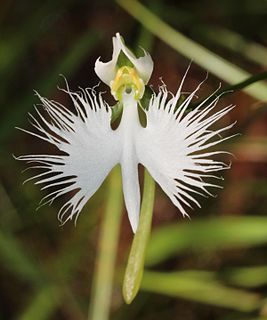
Pecteilis is a genus of flowering plants from the orchid family, Orchidaceae. It is widespread across eastern and southern Asia including the Russian Far East, China, Japan, India, Pakistan, Indochina, and Indonesia.
- Pecteilis cambodiana(Gagnep.) Aver. - Cambodia, Vietnam
- Pecteilis cochinchinensis(Gagnep.) Aver. - Vietnam
- Pecteilis gigantea(Sm.) Raf. - India, Pakistan, Himalayas, Nepal, Bhutan, Myanmar
- Pecteilis hawkesiana(King & Pantl.) C.S.Kumar - Myanmar, Thailand
- Pecteilis henryiSchltr. - Yunnan, Himalayas, Assam, India, Indochina
- Pecteilis ophiocephala(W.W.Sm.) Ormerod - Myanmar, Yunnan
- Pecteilis radiata(Thunb.) Raf. - Primorye, Henan, Japan, Korea
- Pecteilis susannae(L.) Raf. - Fujian, Guangdong, Guangxi, Guizhou, Hainan, Jiangxi, Sichuan, Yunnan, Cambodia, India, Indonesia, Laos, Malaysia, Myanmar, Nepal, Thailand, Vietnam
- Pecteilis triflora(D.Don) Tang & F.T.Wang - Bangladesh, India, Nepal

Murdannia is a genus of annual or perennial monocotyledonous flowering plants in the dayflower family.

Anisochilus is a genus in the family Lamiaceae, first described in 1830. It is native to China, the Indian Subcontinent, and Indochina.
- Anisochilus adenanthusDalzell & A.Gibson - southern India
- Anisochilus argenteusGamble - southern India
- Anisochilus cambodianusMurata - Thailand, Cambodia
- Anisochilus carnosus(L.f.) Wall. - India, Sri Lanka, Nepal, Himalayas, Bhutan, Assam, Myanmar, Thailand
- Anisochilus dysophylloidesBenth. - Shervarayan Hills in Tamil Nadu
- Anisochilus harmandiiDoan ex Suddee & A.J.Paton - Thailand, Laos, Cambodia
- Anisochilus mitisR.A.Clement - eastern Himalayas
- Anisochilus pallidusWall. - Yunnan, India, Assam, Bangladesh, Laos, Myanmar, Thailand, Vietnam
- Anisochilus paniculatusBenth. - southern India
- Anisochilus plantagineusHook.f. - southern India
- Anisochilus polystachysBenth. - Nepal, Bhutan, Assam, Bangladesh, eastern Himalayas
- Anisochilus robustusHook.f. - southern India
- Anisochilus scaberBenth. - southern India
- Anisochilus siamensisRidl. - Thailand
- Anisochilus suffruticosusWight - southern India
- Anisochilus velutinusTrimen - Sri Lanka
- Anisochilus wightiiHook.f. - southern India

Belosynapsis is a genus of mainly perennial plants in the family Commelinaceae, first described in 1871. It is native to Southeast Asia, the Indian Subcontinent, Papuasia, and southern China.
Donald Frederick Blaxell, is an Australian botanist, botanical collector and taxonomist.
A tree in the Salicaceae, or willow, family, Casearia graveolens is a native to an area in Asia from Thailand to South Central Zhōngguó/China to Pakistan. The plant is used in fishing, for fuel, for medicine, as a source of non-edible oil, in construction and as food.
















